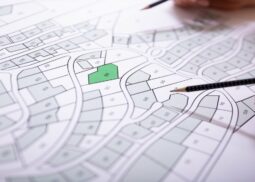Planning Applications: Navigating the Maze of Local Authority Fees:
- May 23, 2025
- Posted by: STL, Glasgow Office
- Category: Insights

So, how much is a Planning Permission Application?
A consistent (and entirely understandable) query we come across with clients revolves around the minefield of local authority planning fees. Be it the scale they are decided upon, the recent increase in fees, or the presence of the surcharge for retrospective Planning Permission applications, there is a lot to grapple with for those not used to the system.
Firstly, there are two factors that determine how much the local authority fee will be for a Planning Permission application. Firstly, the size of a given site or property and secondly, whether or not the fees relate to a retrospective or proposed application.
The fee scale for both Planning Permission applications and Certificate of Lawfulness applications is contingent on the gross external area of a property (this is explained in more detail below).
If the gross external area of a site or property is under 100 sqm the local authority fee as it stands today would be £691, if the site encompasses 100 sqm or more (up to 200 sqm), the fee stands at £1382, and for sites of 200 sqm and over, the fee is £2073 (with fees increasing per 100 sqm increments, thereafter.) More STL use applications fall into the first two brackets, with only particularly large properties invoking fees in the 200 sqm+ fee bracket or higher.
For Planning Permission applications, a retrospective application (i.e. where the applicant has already instigated the use or matter alluded to in the application), an additional 25% surcharge is added to the fees noted above. If the applicant is yet to institute the use or matter, this surcharge is not applicable.
For example, if you were applying for a retrospective Planning Permission application with a gross external floor area of 80 sqm your fee would be:
£691 + 25% surcharge
= £691 + £172.75
= £863.75
However, if you were applying for a retrospective planning permission application with a gross external floor area of 101sqm your fee would be:
£1382 + 25% surcharge
= £1382 + £345.50
= £1727.50
For Certificate of Lawfulness applications, no surcharge is applicable, regardless of whether the application is retrospective or not.
As noted, to calculate the correct fee using the size of a given property, the gross external floor size must be considered. This is not based on a standard “skirting to skirting” (internal) measurement but instead encompasses an entire property, as measured from the outside of one external wall to the other. This often will push the overall square meterage of a property up by 10 (or more) square meters, and sometimes up a fee grade as well.
This is something that can lead to confusion where an applicant has floor plans which only measure the internal floor size, leading to a nasty shock when the local authority then requests more money than was expected.
However, authorities are within their rights to assess fees against external measurements, and those with an internal gross floor size of 90 sqm or more will find themselves (most likely) pushed into the higher scale (and should anticipate a correspondingly higher fee request). This may depend on individual circumstances, however.
There was also a general increase in fees (of 15%) as of the 12th of December 2024.
This has meant that those who applied for Certificates of Lawfulness and Planning Permissions previously (perhaps in the run-up to the STL licensing deadline in October 2023) have now noticed a considerable increase in the fees for any subsequent planning applications made during 2025.
That said, there are circumstances where planning fees are exempted or reduced to a zero sum.
This occurs if an applicant has already made a Planning Permission or a Certificate of Lawfulness application that has been determined within 12 months of the subsequent (similar) application.
For example, a “free go” applies where a follow-up application, dealing with substantively the same matter (at the same site), is made within 12 months of refusal (whether or not at appeal) of an earlier application of the same kind.
As noted, this “free go” only applies for the same type of application. Therefore, if an applicant previously applied for a Certificate of Lawfulness and is now applying for Planning Permission, the fee exemption does not apply. Similarly, the matters alluded to within the application must be materially similar.
Caitlin Anderson.
23.05.25.
Update 10.06.25: On 09.06.25, a new fee scale for planning applications was introduced by the Town and Country Planning (Fees for Applications) (Scotland) Amendment Regulations 2025. The regulations result in a further increase in planning fees, with full details available at:https://www.legislation.gov.uk/ssi/2025/125/regulation/5/made. Further regulations have also introduced fees in respect of certain planning appeals and local reviews. STL Solutions can provide further information.
As can be seen, the matter of planning fees is an evolving and often contentious one, where small differences in the perceived size of a given site can have significant financial consequences. Moreover, ensuring that an applicant’s right to fee reductions or exemptions allowed for can hinge upon a firm grasp of the relevant regulations and knowledge of the planning system. It is always therefore recommended to speak with an experienced planning consultant or solicitor when contemplating an application, particularly if this is not your first engagement with the planning system at a given property or site. STL Solutions has significant experience dealing with fee matters, rationalising and counter-checking external areas and interrogating the planning history of any given site, to ensure that our clients are not subject to inappropriate fees.
About the Author

Caitlin Anderson
Related Services
Reach out to know more
For more insights, please subscribe
For more insights, please subscribe
Contacts
-
STL Solutions
Clockwise, Savoy Tower
77 Renfrew Street,
Glasgow, G2 3BZ
Registered in Scotland: SC771971 -
-

